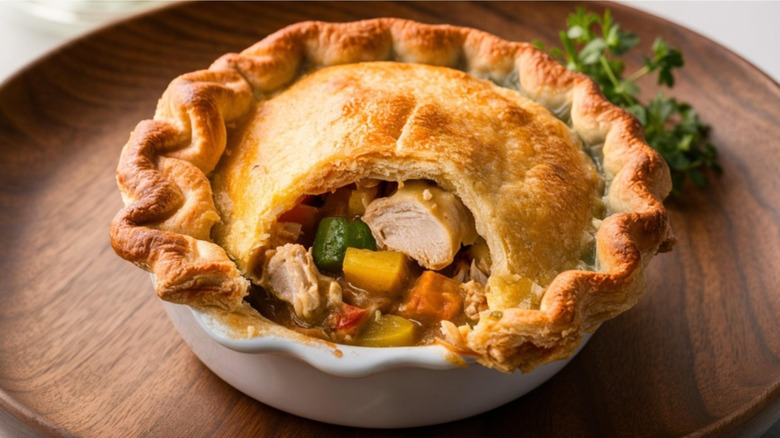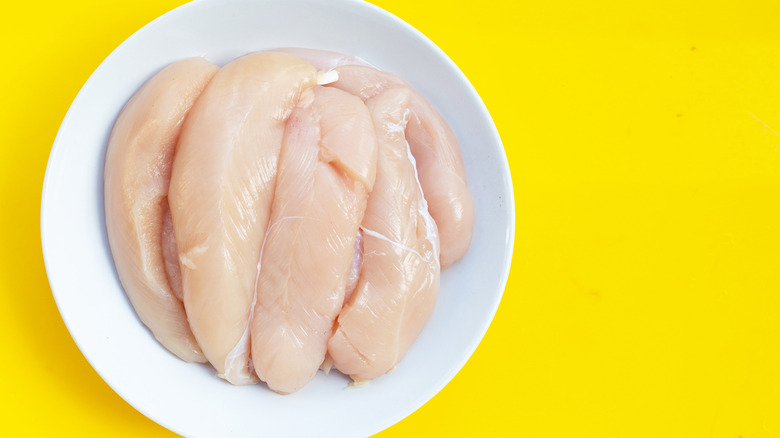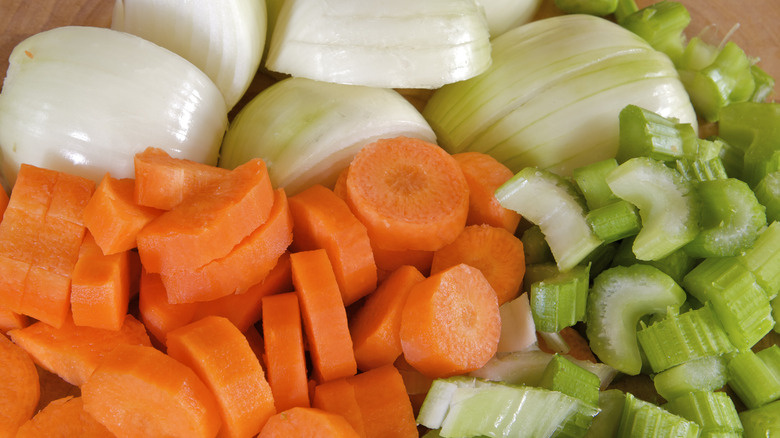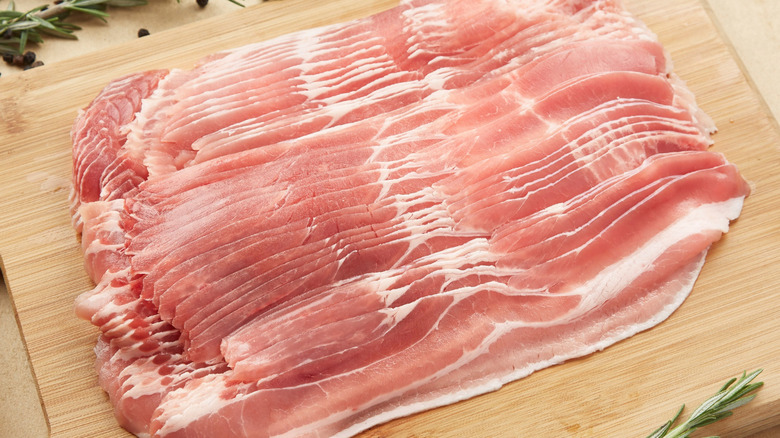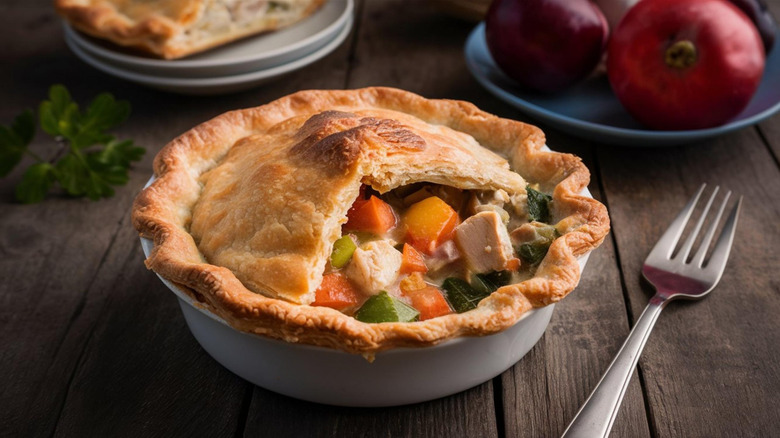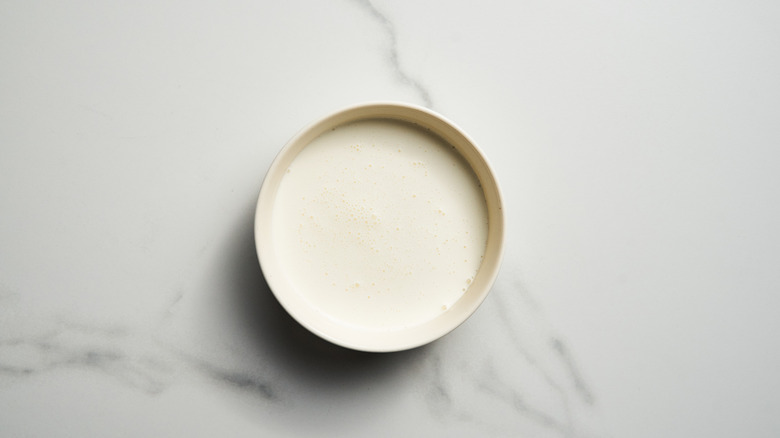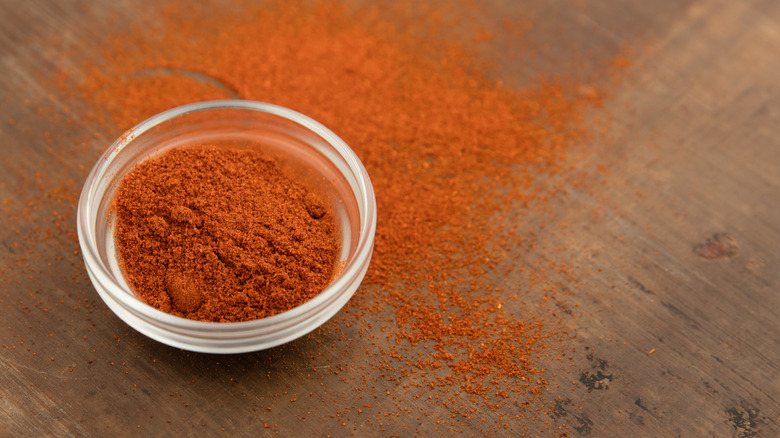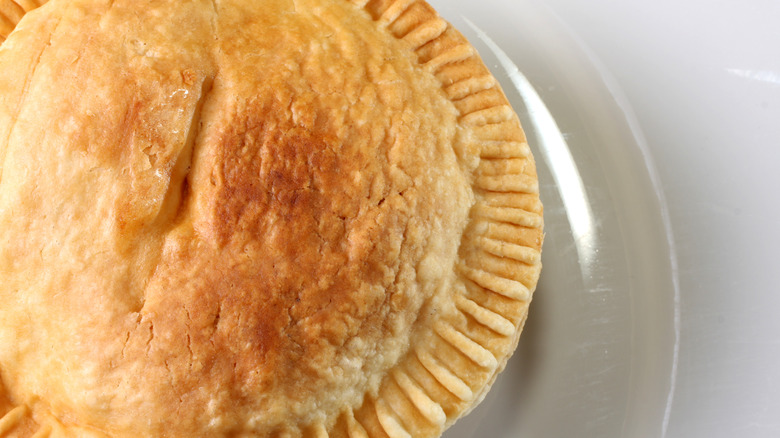14 Reasons Chicken Pot Pie Always Tastes Better At A Restaurant
Is there any dish more universally loved than chicken pot pie? We don't think so. This steaming combination of crisp pastry, tender chicken, and smooth gravy is a total winter warmer and combines textures and flavors to make an all-in-one dish. However, while chicken pot pie is impossibly easy to make, if you want it to be really special, you usually have to go to a restaurant. Sure, you can rustle up a decent pot pie at home, but restaurant chefs know all the tricks of the trade to make perfect pastry, gravy that's just the right thickness, and chicken that doesn't dry out.
Why should they have all the fun, though? In our opinion, home chefs should have just as much access to the techniques that restaurants use to make their chicken pot pies incredible. The good news is that a lot of the ways to make chicken pot pie as good as it can be come down to simple tweaks to technique, sticking to the correct ingredients (while being unafraid to experiment), and pausing at just the right moment. We peeled back the pie lid — see what we did there? — with Josh Evans, executive chef for Cheddar's Scratch Kitchen. A pro when it comes to homestyle comfort food, he told us exactly how Cheddar's makes its pies so darn good.
1. Restaurant chefs use both white and dark meat
The white chicken meat vs dark chicken meat debate shows no signs of slowing down. Dark meat advocates say that it has much more flavor and stays moist and juicy, while those who like white meat like its lightness and gentler taste. Interestingly, while a lot of people prefer dark meat in chicken pot pie, Josh Evans takes a different approach. "I prefer to use chicken tenders because their tender texture holds up well to being baked in the creamy gravy," says Evans.
Chicken tenders and other cuts of white meat have benefits beyond their texture, too. Because they have a slightly milder flavor, white meat cuts provide a better contrast to the salty, savory notes of the gravy. They also don't release any additional fat into the pie, which helps avoid making it too greasy. Plus, the gravy keeps them nice and moist, so you don't have to worry too much about them drying out. However, Evans stops short of telling people not to use dark meat. "I think it's a personal preference and there are benefits to both," he explains.
2. Chefs stick to the classic vegetables — but aren't afraid to experiment
Chicken pot pies are nothing without vegetables, and at Cheddar's, Josh Evans sticks to some tried-and-tested ingredients. "Any good base starts with the classic combination of carrots, celery, and onion," he explains, also mentioning that he throws in garlic too. This combo of ingredients isn't just favored because they're all usually readily available and likely sitting in your pantry. They also all provide different flavor notes. Carrots give your pie some much-needed sweetness without having to pour in sugar, with a hint of earthiness that's highlighted by the gently nutty celery. The onion gives the pie a savory undertone and a mellow fragrance, while the garlic sharpens things up and gives the pie intensity.
However, you don't have to stop there. Evans points out that the beauty of chicken pot pie is its versatility, and you can add pretty much anything you want. "Make it southwestern with chilis and corn, or fancy with mushrooms and asparagus," he recommends. Evans also notes that how you chop your vegetables is super-important to its overall effect. As he says, "Cut them small so they dissolve into the sauce or cut them larger for a heartier version." At the end of the day, the choice is up to you.
3. Chicken isn't the only meat that is used
Restaurant chefs aren't shy about using other meats in their chicken pot pies. While you can make an excellent pot pie with just chicken, throwing in some bacon is fairly common practice for chefs. Bacon or other pork products, like pancetta or lardons, give your pot pie an intensely savory flavor that adds so much richness to the overall effect. They also contribute to its seasoning with their deep saltiness, add a note of sweetness that picks up the umami flavors in the pie filling, and imbue it with a little smokiness to finish things all off.
Bacon releases fat as it cooks, which adds to the sumptuous texture of your roux. It also gives your pie filling a more dynamic visual appearance: While most people don't eat pot pie because of how the filling looks, it's nice to have those little flecks of deep pink in that sea of white. If you don't like bacon, though, you don't have to use it. Your chicken pot pie will still be plenty flavorful without it, and you can add other ingredients like Worcestershire sauce which give extra saltiness and umami.
4. Chefs nail their roux
Your roux is the thing that holds your pot pie filling together, quite literally: This combo of flour and butter that kicks off your gravy thickens it and ensures that every spoonful is creamy and delicious. "Using a roux to thicken your sauce adds flavor and a velvety texture," says Josh Evans, and while it can seem complicated, taking shortcuts with other ingredients to gain thickness will never give you that restaurant result.
Getting a roux right, however, can be trickier than you think. Restaurant chefs know that it pays not to rush things. "Make sure you are cooking the roux long enough until it gets a nice golden-brown color," Evans suggests. By lightly toasting the butter-and-flour combo, you develop a little extra caramelization that deepens the overall flavors of your gravy. Taking it slowly and stirring it constantly is also one of the easiest ways to stop a roux from burning. Additionally, it's important to use the right ratio of fat to flour. Aim for a perfect 1:1 ratio, which will stop your flour from being too dry and scorching.
5. At restaurants, a combination of herbs is used
Herbs are a must in restaurant chicken pot pies, and for good reason. Without herbs, chicken pot pies can get a little too dense and one-note in flavor, and can feel almost incessantly savory. Herbs cut through this savoriness beautifully, adding a bright fragrance and a layer of grassy, zingy flavor throughout.
One thing restaurant chefs aren't telling you, though, is that they often combine multiple herbs in one go. "Herbs like thyme, rosemary and parsley all work great," says Josh Evans. Using a combination of herbs allows the flavors of each individual herb to fill in extra flavor dimensions, with more floral herbs like rosemary working against earthier flavors like parsley. Sage is also a great choice, and gives your pot pie a real warmth and a deep aroma. Additionally, tarragon is one herb that can give chicken salad a boost, and it can have the same effect in a chicken pot pie, with a milky sweetness to it that lifts the creamy notes of your gravy. Honestly, though, you can kinda use any herbs you want — just make sure they're balanced well with each other, and you're not using too much of one over the others.
6. Cream is a consistent feature
You want to know the secret to chicken pot pie? Cream, and lots of it. Cream adds an intense dairy flavor to your gravy and a richness that both keeps the chicken moist and develops its taste. The cream and its dairy fats help to offset any salty and savory notes, mellowing out the flavors throughout the pie.
This ingredient, which is a favorite of Wolfgang Puck in his chicken pot pies, should be added after your roux has fully thickened. Adding it once your roux is prepared allows you to assess exactly how much it will thin it out. It's also a good idea to only add a little bit at a time, stirring it in and tasting the roux before you add any more. You can use light or heavy cream, it's up to you — just remember that heavy cream will add way more richness. Also keep in mind that while you want a healthy amount of cream here, you don't want to flood your dish with it, as this will thin out your gravy too much and slightly dull the other tastes.
7. They like to add a little spice
Chicken pot pies tend to trade heavily on herbal and savory flavors, but one nifty secret is that restaurant chefs like to use spice. Spices like chili flakes and cayenne pepper add a tiny touch of heat to your pot pie, without making it overly fiery. Instead, the heat adds a counterbalance to the rest of the flavors, and gently intensifies its savoriness. It also gives it a nice touch of warmth that slowly develops as you eat the pie.
However, the most important thing is that you don't overdo it. A pinch or two of cayenne pepper may make things slightly more complex, but add too much and your pie will just be full-on spicy. The joy of this meal is that it's comforting, and you can wolf it down in a matter of seconds (well, once you've let it cool off, that is), and neither of those things will be true if you've made your pie as fiery as a Thai red curry. Add a tiny bit at a time to your chicken and vegetables, and taste them periodically to make sure they're not too hot.
8. Restaurant chefs keep it classic with their pie wash
While it's not essential to add a pie wash, brushing your chicken pot pie with one will work wonders. An egg wash will give your pie a lustrous sheen and help it brown more efficiently, making your meal all the more appealing to look at. However, with so many different types of pie crust washes, picking the right one can be tricky. Do you use cornstarch? Almond milk? Aquafaba?
According to Josh Evans, the answer's far more simple. "A 50/50 blend of egg and water works to add a nice sheen to the top of your crust," he says. An egg-water mixture has just the right balance of proteins, fats, and moisture, and these help to gently darken the color of your pie without burning it, giving a delightful shininess that makes it a treat for the eyes. The water helps to thin the mixture out so that everything doesn't get too intense, and also makes it easier to spread. If you don't have any eggs to hand, or you've used them all in your pastry, a heavy cream or milk wash can also give your pie a fabulous appearance.
9. Restaurants use house-made stocks
The best chicken pot pies avoid using water to build the gravy. Instead, they thin out the roux with chicken stock, which gives it a deep, savory flavor and seasons it effectively. One of the reasons that restaurant chicken pot pies are better than homemade ones, though, is that they put just as much care into their stocks as they do every other ingredient. Stock or bouillon cubes just won't cut it here, folks.
Making a basic chicken stock is surprisingly simple, and so you likely won't struggle too much to do so. If you want to produce a restaurant-quality stock, though, you should take Josh Evans' advice. "When making your own stock, the key is roasting the bones before simmering to make your stock rich," says Evans. This will deepen its meaty flavor and introduce caramelized notes into the stock. Evans also recommends going for additions that boost savoriness even further. "Adding umami-rich ingredients like tomato paste, roasted garlic, or mushrooms to your stock will create a well-rounded rich broth." You can even try adding a little soy or fish sauce into the mix, which can also give your stock a lightly golden color.
10. Restaurant chefs stick to tried-and-true pastry
We've all been in those restaurants that like to show off how differently they do things — but when it comes to this dish, it pays to keep it classic. That extends to its pastry, too. "I'm a fan of a traditional shortcrust because I think it has a richer flavor," says Josh Evans. There are lots of different types of pastry dough out there, but shortcrust is the one you should stick to with chicken pot pie, thanks to its high-fat ratio and crumbliness. This fattiness gives it a buttery, rich quality that pairs astoundingly well with your filling, and its slightly biscuity quality helps to keep your gravy contained.
If you want to try something new, though, there are a few other pastries you can use. Puff pastry tends to go really well with chicken pot pies, and its flaky-on-the-outside, stretchy-on-the-inside consistency gives the dish a delightful texture contrast. A classic flaky crust can be a good option if you want a middle ground between shortcrust and puff pastry, as it gives you a flaky texture while also remaining sturdy.
11. Restaurant chicken pot pies have a secret ingredient — butter
Forget your vegetable oil, your lard, or your alternative fats. When it comes to chicken pot pie, there's only one fat that matters. "Good, high-quality butter," explains Josh Evans, is the secret to a delicious chicken pot pie.
In your pastry, butter acts as both a flavor enhancer and a texture element. It gives your shortcrust a creamy, rich taste, with its fats also producing that all-important crumbliness that makes it so moreish. Additionally, butter works to "waterproof" your pastry: By adding lots of high-quality fat, your pastry is able to firm up effectively and retain your gravy without getting too soggy. It's important to keep it as cool as possible when adding it to your pastry, so that it doesn't melt into the flour and make things greasy.
However, butter is a key ingredient in other parts of the pie too. It's a key component of your roux, giving it smoothness and depth. It's also fantastic for frying your pot pie ingredients in, as it gives them extra richness — especially useful if you're using white meat. Having said all this, don't go overboard with your butter. You don't want your pie to be greasy, just smooth-tasting and velvety.
12. Restaurant chefs know the importance of waiting
You may think of restaurant kitchens as frantic, stressful places — and in some cases, you'd definitely be right. When it comes to chicken pot pies, though, chefs are a little less like those in "The Bear" and take a slightly more zen approach to their construction. Restaurant chicken pot pies have a perfect contrast between crunchy, firm pastry and creamy pot pie filling because chefs take a pause before they put their pie lids on. Once the chicken pot pie filling is cooked and piled into the dish, they usually wait for around 15-20 minutes before crowning it with pastry.
Why? Well, it's worth remembering that pastry is incredibly susceptible to moisture and heat. If you place your pastry crown on a steaming mound of chicken and vegetables, the steam it releases will moisten and soften your pastry. This will increase its water level, and make your pastry gluey, heavy, and stretchier — and stop it from cooking as thoroughly. As well as this, it can cause the butter in your shortcrust to start to melt, which makes things oily and unpleasant. You want a killer pot pie? Set your timer, pour yourself a glass of wine, and put your feet up.
13. Chefs don't score their pie pastry
Most pies aren't complete until the chef has added a steam-release valve. Whether this is achieved by scoring the pastry on top, or creating a cross-hatch pattern with your pie lid, considering how the steam from your filling gets out is usually essential. However, with restaurant pot pies, they tend not to score their pastry at all. Instead, they top the pie with its crust, and throw it straight in the oven.
The reason they do this is so that they can harness the power of that steam to create height. When you don't score the pastry, the steam inside puffs up the pie lid, creating an impressive dome that gently cracks on its outer layers. It also increases the pastry's surface area by gently stretching it, giving you more of that crispy exterior. Importantly, this tends to happen with stretchier doughs like puff pastry, and less so with firmer ones like shortcrust. If you're concerned about steam and your pie bursting, you can still score your pastry — the choice is up to you.
14. Leaving the pie to rest is an essential step
It takes a lot of willpower not to dig into your chicken pot pie the moment it comes out of the oven. However, if you want yours to be as good as the kind you get in restaurants, you're gonna have to wait a little longer. When chefs pull their pies out of the oven, they usually rest them for approximately 15 minutes or so before serving. No need to do this on a windowsill, though — the counter will do.
Once the resting period is complete, they then dish 'em up and send them to the table. The reason for this resting process is so that your pie filling isn't molten hot when it arrives at your table, and this allows you to discern the individual flavors in your pot pie way better. It also stops your pie filling from falling apart: As it cools, the gravy pulls together and thickens slightly. Don't worry about it getting too cold, either. The pie crust will insulate the filling, so it'll still be warm and delicious.
